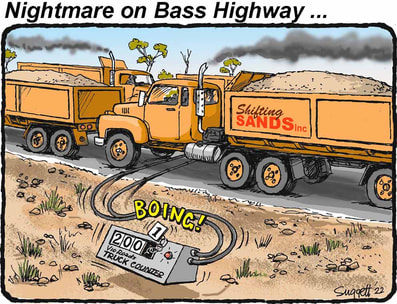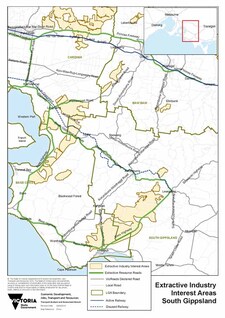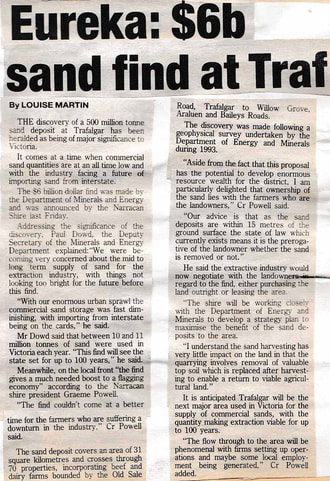
FREIGHT Victoria has identified the Bass Highway as the major freight route for sand, rock and gravel from projected vast new mines between Leongatha and Inverloch.
Extractive Industries of South Gippsland, Supply Chain Study identifies a 160km journey from Leongatha South via the Bass Highway as the preferred haulage route to Melbourne, with potentially devastating consequences for Inverloch, Wonthaggi, Dalyston, Kilcunda and Grantville.
The 2019 study concludes demand for extractive resources from South Gippsland will increase rapidly from below 4 million tonnes in 2015 to over 24 million tonnes by 2050.
“The preferred routes for extractive resources from South Gippsland to markets in Greater Melbourne and beyond are from Leongatha via the Bass Highway, and from Lang Lang via the South Gippsland Highway."
Extractive Industries of South Gippsland, Supply Chain Study
 South Gippsland supply chain study area.
South Gippsland supply chain study area. “Damage to roads will also increase, resulting in increased road maintenance costs and an associated increase in congestion and traffic delays, alongside significant safety issues.”
And it says local government will share responsibility with state government and industry for construction and maintenance of these roads.
The freight study is based on a 2016 report by corporate accounting firm PWC that identified South Gippsland (including Bass Coast) as the most critical resource location for sand and hard rock supplies for future construction in Melbourne.
Bass Coast geologist Ted Minty said a 2019 review by the Geological Survey of Victoria (GSV) concluded there was insufficient geotechnical evidence to support PWC’s conclusions. “Yet the Government has continued to rely on this flawed PWC report to support sand mining in the Western Port Woodlands.”
He said future extraction of sand/gravel and basalt at Leongatha South for Greater Melbourne, with haulage via the Bass Highway, would cause massive disruption to the communities of Bass Coast, a massive cost to the consumer and a massive burden on the Victorian taxpayer.
Mr Minty was commissioned by community group Save Western Port Woodlands (SWPW) to do a desktop study identifying alternative sand supplies in Victoria outside areas of high biodiversity.
He says larger reserves of sand and gravel are located much closer to Melbourne on low value farmland in Cardinia and Baw Baw shires with access to Melbourne via freeway and rail.
 Latrobe Valley Express, Sept 6, 1994
Latrobe Valley Express, Sept 6, 1994 At the time, the deputy secretary of the Department of Minerals and Energy estimated there was enough sand to meet Melbourne’s needs for the next 100 years.
The resource was valued at $6 billion at the time, with the local shire president saying it could create enormous resource wealth for the shire.
In the 28 years since then, the Trafalgar sand resource has not been exploited and no further substantial testing has been done in Victoria.
Mr Minty found successive state governments have failed to identify and assess alternative mineral resources essential for Victoria’s long-term building needs.
“Long-term planning for Victoria’s resource supplies is hampered not just by a lack of data but also by a lack of a vision. An efficient supply chain should align with long-term urban planning models for South East Melbourne and use existing road and rail infrastructure without causing unnecessary damage to Victorian transport infrastructure.
“The general geology of the Melbourne Supply Area suggests there are extensive sheets of sand/gravel north of the Princes Highway in the shires of Cardinia and Baw Baw associated with the Haunted Hills Gravel stratigraphic unit.
“If large deposits of sand/gravel could be developed here, it would give close access to the Princes Highway on relatively low-value agricultural land and with considerable cost savings on transport compared to extraction from the Western Port Sunklands in Bass Coast and South Gippsland.”
Mr Minty said these alternate deposits present minimal risk to the environment and minimal impact on transport infrastructure. Darnum appears a logical site to develop a major hub for the distribution of sand/gravel to Greater Melbourne by rail and road (the Princes Highway).
“The ongoing exploitation of sand and gravel beneath the Western Port Woodlands, the last significant remnant forest in the Gippsland Plains bioregion, represents very poor governance by the responsible authorities in both environmental and economic terms.”